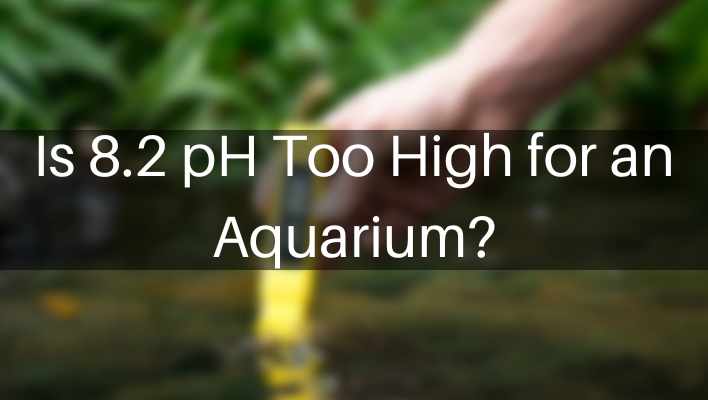
Are you worried about fish in your aquarium? I bet you are.
Worrying about parameters in an aquarium is perfectly reasonable, especially when they are above the optimal range. We don’t want to wake up to dead fish in an aquarium!
With that in mind, is 8.2 pH too high for an aquarium?
No, a pH of 8.2 is not too high for an aquarium. A pH of 8.2 is ideal for many fish species and encourages a healthy biological filtration system. Most aquarium fish prefer water with a pH between 6.5 and 7.5, but many hardy species can survive – and even thrive – in slightly alkaline water with a pH of 8.2.
It’s always best to research the ideal water parameters for the specific species of fish you are keeping, so you can make sure they are comfortable in their environment.
However, are we asking the right question? Is it essential to chase an official pH value? Is there a better angle to the pH puzzle?

Stay tuned to learn more!
pH: A Brief Explanation
Before we explore whether our article’s question is the right way to go about this, let’s get on the same page about pH.
What is pH? To understand pH, we need to refresh our chemistry. Yes, let’s go back to the ‘fun’ chemistry practicals.
Acids and bases, remember them. pH is a scale that measures the level of acidity or alkalinity of watery solutions. Acids run from 1 to 6.9, whereas bases run from 7.1 to 14.
pH denotes (historically) “potential of hydrogen” or “power of hydrogen”.
The higher the concentration of H+ ions, the more powerful an acid is.
Wikipedia
What is 7.0 on the pH scale? If you noticed seven’s absence, pat yourself on my behalf. You are keen!
Seven is neutral. Liquids or solutions that land at seven on the scale are neither acidic nor basic. As luck would have it, only pure and distilled water are perfectly neutral.
Therefore, acids and bases are weaker when they measure close to seven. For instance, an acid with a pH of two is stronger than an acid with a pH of five.

Alright, that’s enough chemistry for this article. Given what we know about pH, what does it have to do with an aquarium?
pH in a Fish Tank
pH is a significant parameter in a fish tank. That’s why we measure it regularly (also why you are reading this too).
In short, we aim to keep pH in the ideal range for fish. As mentioned before, every fish has an optimal range where they thrive.
If you want to know a fish’s ideal pH range, it will help to check its origins. Original habitats tell us much about the conditions fish survive best in.

Generally, a fish tank should not be too acidic or basic. It is fatal. Fish will die in strong alkaline or acidic water.
It is vital to keep the pH within the fish’s ideal range. Most fish prefer slightly alkaline environments, while a few love slightly acidic water.
What is the Best Angle for Aquarium pH?
At this point, I hope you have a firm grasp of pH in a fish tank. Right? Perfect, let’s continue with the article topic, high pH.
Should we try to maintain an official optimal pH value? Is it the best approach to pH in a fish tank?
As previously mentioned, each fish has an optimal pH value. A value that the y can fully thrive and be happy like royalties do at the end of most fairytales.
How can we maintain an optimal pH for each fish in the same tank? It is impossible. You can’t do it.
Yes, it is arduous to maintain an optimal pH value even in a fish tank full of the same type of fish. Why?
There are too many variables involved. pH is very sensitive. So much so that even dropping fish food into the tank can cause a spike.
You’ll be doing more harm than good regulating it every time you change, fix, or add something to the aquarium.
So, what else can we do? Like most stuff, you must maintain a consistent value within the fish’s ideal/safe pH range.
Don’t worry about your fish. They can adapt to anything that won’t irritate or kill them.
It is much better and easier to keep pH stable than to chase a single optimal value. As long as other parameters are suitable, a stable pH works excellently.
What pH is too high for Fish?
It is widely accepted that fish can’t live in water with a pH of nine or above. At this point, ammonia concentration is too high and toxic for fish.
High pH levels can cause various problems with the fish’s physiology, making it impossible for them to survive in these conditions.
It is important to remember that it is not just fish that can be adversely affected by high pH levels. Plants, bacteria, and other organisms can suffer when pH levels become too high.

As such, ensure that the pH of aquarium water is kept within a healthy range for all aquatic life. Additionally, test the pH level of aquarium water regularly and adjust it if necessary to ensure a healthy environment for all inhabitants.
Causes of High pH in a Fish Tank
They say prevention is better than cure. Instead of reacting to a pH increase, preventing it is much better and more straightforward.
How can we prevent high pH in an aquarium? By understanding how we get to high pH.
Below are a few factors that increase pH in fish tanks:
Water Changes
Yes, you shouldn’t perform water changes based on whims. Instead, let the tank guide you.
Frequent or infrequent water changes increase the pH in a fish tank. Performing water changes too frequently can remove beneficial bacteria and other organisms from a tank, raising pH levels.
Performing water changes too infrequently can lead to an accumulation of pollutants and dissolved organics in the tank, leading to increased pH levels.
Take a balanced approach and establish a routine for changing water. Unless there is an emergency, you must stick to the pattern to maintain a stable pH.

Mineral/Chemical Buildup
Excess minerals are bad news for an aquarium’s pH stability. Rocks and other objects in the aquarium contain elements such as calcium.
These minerals can also come from tap water, supplements, fish medications, and other additives. The elements or minerals dissolve in tank water. Consequently, the pH rises.
Filtration
Anyone with an aquarium will tell you how important a well-functioning filter is to an ecological balance in a fish tank.
A poorly functioning filter will lead to a buildup of toxic chemicals in the aquarium—organic matter such as fish waste and uneaten food.
Additionally, if the filter is not cleaned regularly (or if the filter media is not routinely replaced), it may become clogged with debris, leading to a buildup of organic matter.
The buildup of organic matter will lead to an increase in ammonia. Ammonia will raise water’s alkalinity, raising the pH significantly.
Inadequate filtration can also contribute to high pH levels. If a filter is not powerful enough for the size of the tank, it may not be able to remove enough dissolved organics from the water, causing the pH to rise.
Carbon Dioxide
Carbon dioxide combines with water to form carbonic acid. Therefore, when more carbon dioxide is available, the pH value reduces.
The lack or absence of carbon dioxide leads to an increase in pH. Thus, the more plants and algae consume carbon dioxide, the higher the pH of water.
Aeration also increases pH. How? During the aeration of water, more oxygen dissolves in water while carbon dioxide escapes into the air. As such, water becomes more alkaline during aeration.

Overstocking
Overstocking a tank can contribute to high pH levels. If a tank is too heavily stocked with fish and other aquatic life, it can increase waste and pollutants in the water.
As you know, beneficial bacteria will break the organic matter into ammonia, resulting in high pH levels.
Reducing a Fish Tank’s pH Level
Here are a few quick and natural ways of lowering pH in an aquarium:
- Adding Indian Almond/Cappata Leaves and driftwood into the tank.
- Using peat moss in the filter.
You can also use sodium bicarbonate (baking soda) to lower the pH level. However, you must be mindful of the dosage. Too much of it will cause other problems.
I prefer natural solutions (probably an unconscious bias). The recommendation is to use baking soda when needing an urgent solution.
Final Thoughts
It is better to keep the pH level stable than to go crazy about an optimal pH value. It is easier and safer for fish.
Fortunately, fish are easily adaptable to their environment’s conditions—a positive of the fight for survival in the wild.
Always be on the lookout for abnormal fish behavior. They can alert you to a concern that may need you to adjust pH or other parameters in water.

Jesse is the principal author of this blog. He is an avid fishkeeper with rich experience spanning several years. He is here to share his knowledge and ensure you also have a guiding compass, as he did with his father.